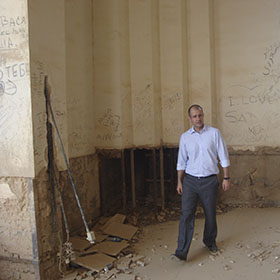Mapping the ‘cultural genocide’ in Iraq and Syria
Media releaseThe destruction of ancient heritage sites across Iraq and Syria by fundamentalists, such as the Islamic State's annihilation of the ancient Assyrian city of Nimrud reported this weekend, is cultural genocide on a scale that has never been seen before, according to a Deakin University Middle East expert.
To ensure this 'industrial scale' heritage destruction is not simply cast aside with the rubble, Dr Ben Isakhan, a senior research fellow and convenor of the Middle East Studies Forum with the University's Alfred Deakin Research Institute for Citizenship and Globalisation, is mapping the scale of the loss and developing an understanding of how and why it has occurred in the hope further devastation can be minimised or prevented in the future.
"Human beings have been destroying heritage sites for thousands of years," Dr Isakhan said.
"What marks the situation today is the industrial scale. It is no longer arrows or shovels that are being used to destroy monuments and artefacts. The technology exists today to completely blow up a church or flatten a monument with bulldozers, or as we saw with Nimrud this weekend, totally obliterate an entire ancient city. The destruction is unprecedented in human history, and what is lost can never be replaced, some of which is over 4000 years old."
The destruction is not just targeting Iraq's heritage, but human civilisation – "the complete deletion of a very significant chapter," he said.
"Syria and Iraq are the cradle of human civilisation. They are among the most archaeologically rich and heritage dense countries in the world, having supported the Ancient Mesopotamian, Byzantine, Greek and various Islamic cultures – as well as hundreds of the first Christian monasteries and churches. A sequence of empires and religions and ways off life have existed there for millennia."
With a major grant from the Australian Department of Defence, Dr Isakhan will create sophisticated databases that document the heritage destruction in Iraq and Syria.
Compiled through primary material from interviews and some fieldwork as well as secondary material, provided by NGOs and the media, the databases will be presented to the international academic community, as well as the Iraqi and Syrian governments, and international bodies, such as UNESCO and the Arab fund.
"They will provide a detailed study of the trajectory, the types of sites, and the motivations for why they are being attacked," Dr Isakhan said.
"It will be a huge map that indicates the date the destruction took place, the significance of the site and the nature of the damage. It will help us to make arguments about how this destruction could be minimised in the future, through counter measures, for instance, and how we could prevent future destruction as other states encounter similar strife."
The project continues work begun through an Australian Research Council Discovery Early Career Researcher Award (DECRA), which focussed on documenting the heritage destruction that occurred during the US-led occupation of Iraq from 2003-2011. Extending on the existing database of around 800 heritage sites, the new project will focus on the destruction after the US withdrawal and extend to Syria.
As to the reasons for the targeting of monuments, Dr Isakhan attributes this to a variety of different factors including "the iconoclasm of religious fundamentalism".
"Early Christian religions also believed that false idols disrupted the relationship between humans and God. It is an old phenomenon in both Christianity and Islam," he said.
However, there is a strong element of opportunism by the fundamentalists, who are selling looted artefacts to provide money for the cause.
"Antiquities are arguably one of the biggest revenue streams for IS. Whatever they can smuggle out and sell, they will, but if they can't, they will blow it up. These are priceless monuments and artefacts, such as the 2000 year old Hatra site and the ancient Assyrian winged bull statues in North Iraq that have been destroyed in recent months," Dr Isakhan said.
Share this story
 Dr Ben Isakhan in the remains of one of the rooms in Saddam Hussein's palace in Babylon
Dr Ben Isakhan in the remains of one of the rooms in Saddam Hussein's palace in Babylon
